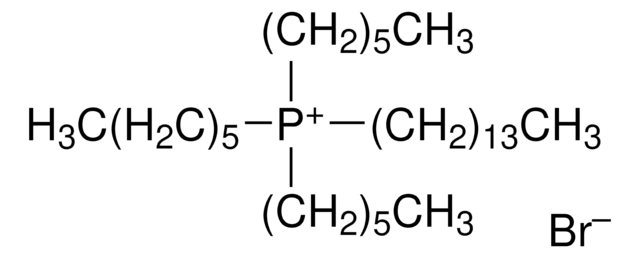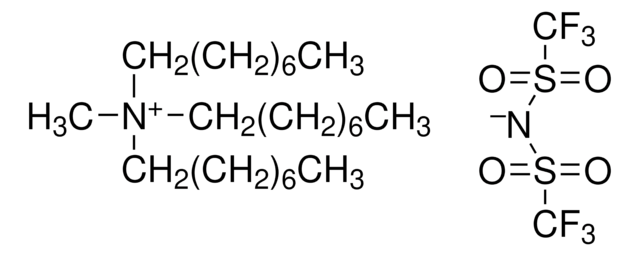50971
Trihexyltetradecylphosphonium bis(trifluoromethylsulfonyl)amide
≥95.0%
Synonim(y):
Tetradecyltrihexylphosphonium bis(trifluoromethylsulfonyl)amide
About This Item
Polecane produkty
Próba
≥95.0%
zanieczyszczenia
≤1.0 water (Karl Fischer)
gęstość
1.07 g/mL at 20 °C (lit.)
ciąg SMILES
FC(F)(F)S(=O)(=O)[N-]S(=O)(=O)C(F)(F)F.CCCCCCCCCCCCCC[P+](CCCCCC)(CCCCCC)CCCCCC
InChI
1S/C32H68P.C2F6NO4S2/c1-5-9-13-17-18-19-20-21-22-23-24-28-32-33(29-25-14-10-6-2,30-26-15-11-7-3)31-27-16-12-8-4;3-1(4,5)14(10,11)9-15(12,13)2(6,7)8/h5-32H2,1-4H3;/q+1;-1
Klucz InChI
HYNYWFRJHNNLJA-UHFFFAOYSA-N
Powiązane kategorie
Opis ogólny
Zastosowanie
- The electrodeposition of nano and microcrystalline metals for electrochemical applications.
- The synthesis of amino acid ionic liquid functionalized graphene (AAIL-GR) applicable as a biosensor.
- The investigation of interactions between ionic liquids and fluorinated alkanes.
- The synthesis of pure rutile and anatase phases of nanocrystalline TiO2.
Inne uwagi
Hasło ostrzegawcze
Danger
Zwroty wskazujące rodzaj zagrożenia
Zwroty wskazujące środki ostrożności
Klasyfikacja zagrożeń
Eye Dam. 1 - Flam. Liq. 3 - Skin Corr. 1B
Kod klasy składowania
3 - Flammable liquids
Klasa zagrożenia wodnego (WGK)
WGK 3
Temperatura zapłonu (°F)
125.6 °F
Temperatura zapłonu (°C)
52 °C
Środki ochrony indywidualnej
Faceshields, Gloves, Goggles, type ABEK (EN14387) respirator filter
Certyfikaty analizy (CoA)
Poszukaj Certyfikaty analizy (CoA), wpisując numer partii/serii produktów. Numery serii i partii można znaleźć na etykiecie produktu po słowach „seria” lub „partia”.
Masz już ten produkt?
Dokumenty związane z niedawno zakupionymi produktami zostały zamieszczone w Bibliotece dokumentów.
Klienci oglądali również te produkty
Nasz zespół naukowców ma doświadczenie we wszystkich obszarach badań, w tym w naukach przyrodniczych, materiałoznawstwie, syntezie chemicznej, chromatografii, analityce i wielu innych dziedzinach.
Skontaktuj się z zespołem ds. pomocy technicznej











